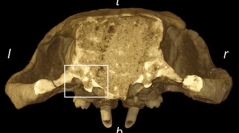

 Comptes Rendus Palevol
9 (6-7) - Pages 319-330
Comptes Rendus Palevol
9 (6-7) - Pages 319-330The derived middle and inner ears of mammals are the major features distinguishing them from non-mammalian vertebrates. Among them, multituberculate mammals represent an important transitional stage and a groundplan for further therian ear evolution. We present the reconstruction of petrosal features of a new multituberculate from the Late Cretaceous of Inner Mongolia (China) based on high resolution computed tomography and three-dimensional imaging analysis. Besides questioning some aspects of previous interpretations, this study reveals a combination of derived and primitive characters, such as a therian-like vascular and nervous pattern and internal acoustic meatus, and a monotreme-like inner ear, but with a derived semicircular canal planarity. The possible presence of a primary bony lamina for the basilar membrane could demonstrate that the first step in the elaboration of a coiled cochlea was already present in multituberculates. Auditory capabilities can be deduced for this animal, which was certainly terrestrial and possibly fossorial.
Bony labyrinth, Computed tomography, Ear, Evolution, Mammalia, Petrosal bone